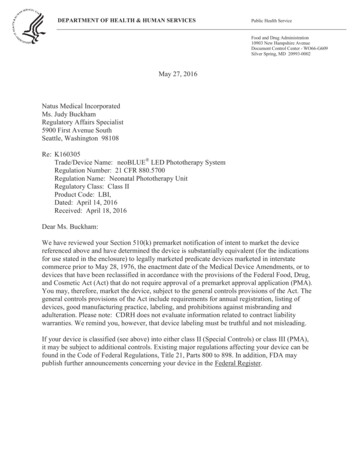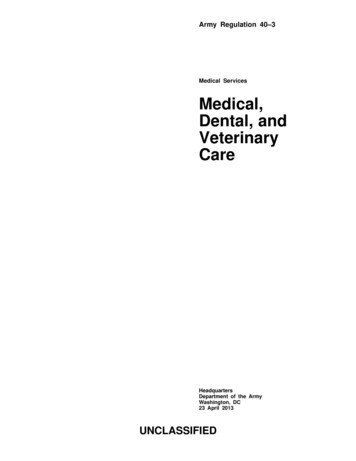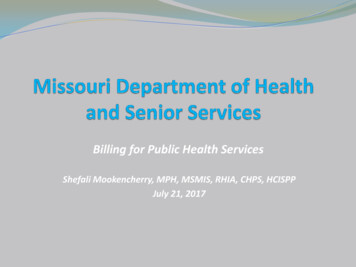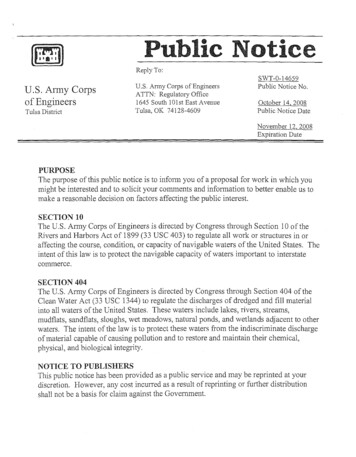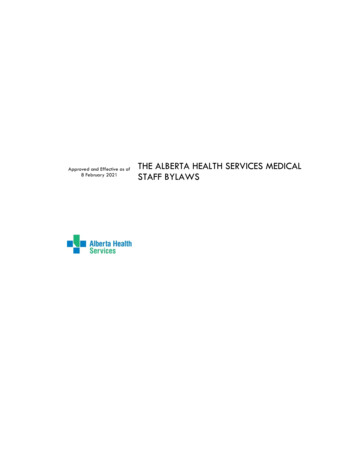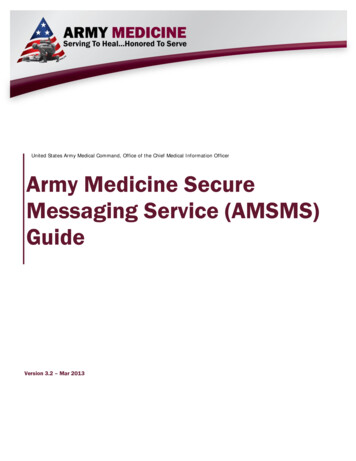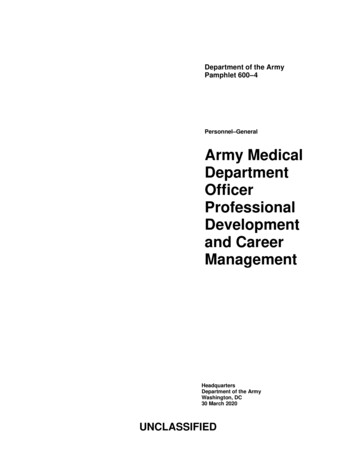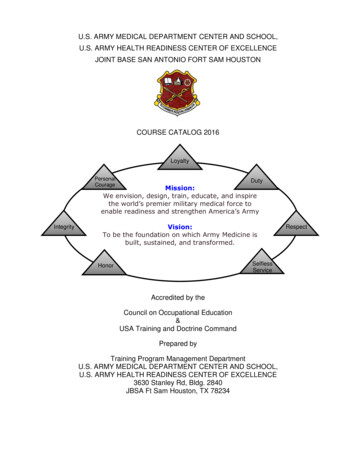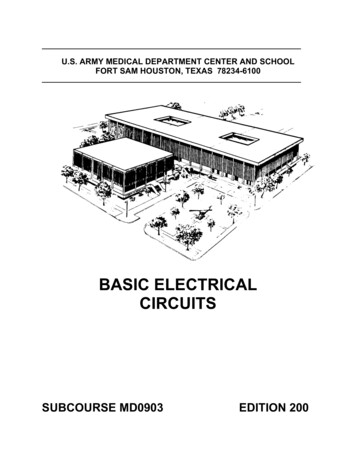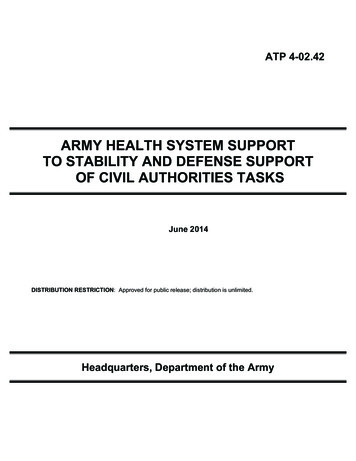
Transcription
Department of the ArmyPamphlet 40–11Medical ServicesArmy PublicHealthProgramHeadquartersDepartment of the ArmyWashington, DC18 May 2020UNCLASSIFIED
SUMMARY of CHANGEDA PAM 40–11Army Public Health ProgramThis major revision, dated 18 May 2020—oChanges the title of the pamphlet from Preventive Medicine to Army Public Health Program (cover).oCharacterizes the types of organizations that comprise the Army Public Health Enterprise and outlines the functionsand activities for governance of the Enterprise (paras 1–6 and 1–7).oIdentifies conditions when Army public health practices are applied at Joint bases and privatized facilities (paras 1–8and 1–9).oIntroduces the Public Health Service Line and its role in the Enterprise governance process (para 1–10).oCharacterizes the different levels at which public health services are executed across the Army (para 1–12).oAdds guidance for implementing quality management within each level of the Army Public Health Enterprise (chap2, paras 12–17 through 12–22, appendices B and C).oIdentifies official Department of Defense and Army information systems used to archive and manage public healthsurveys, inspections, surveillance, exposure, and other related data (chap 3).oUpdates the guidance and procedures for conducting health risk assessments (chap 4 and app D).oUpdates the guidance and identifies resources for public health communication (chap 5 and app E).oUpdates the activities and guidance associated with health surveillance and epidemiology (chap 6 and app F).oUpdates activities and guidance associated with occupational health; introduces the scope and function of occupationaland environmental medicine; and adds guidance for managing exposure to depleted uranium (chap 7 and app G).oAdds guidance for occupational health activities associated with workers’ compensation claims (para 7–33).oUpdates activities and guidance associated with environmental health (chap 8).oIntroduces facility sanitation and hygiene (para 8–38).oAdds the public health functions of the Army Veterinary Service and characterizes the One Health concept (chap 9).oRenames “Field Preventive Medicine” as “Operational Public Health” and updates the guidance and activities foradministering public health in the operational environment (chap 10).oRenames “Disease Prevention and Control” as “Clinical Public Health” and updates associated guidance and activities(chap 11).oRenames “Soldier, Family, Community Health, and Health Promotion” as “Community-based Prevention and HealthPromotion”; updates associated activities and guidance; introduces the Performance Triad concept; and adds guidancefor Army Wellness Centers (chap 12 and appendices H and I).
oRenames “Preventive Medicine Toxicology” as “Public Health Toxicology” and updates associated activities andguidance (chap 13).oRenames “Preventive Medicine Laboratory Services” as “Public Health Laboratory Services” and updates associatedactivities and guidance (chap 14).oAdds activities and guidance associated with public health emergency management and response teams (chap 15).oUpdates terms (glossary).
HeadquartersDepartment of the ArmyWashington, DC18 May 2020*Department of the ArmyPamphlet 40–11Medical ServicesArmy Public Health ProgramHistory. This publication is a major revision.of the Army across the range of military operations from military engagement, securitycooperation, and deterrence through largescale combat operations, to include activities during mobilization. It also applies toU.S. Army Reserve personnel on activeduty or in drill status; U.S. Military Academy cadets; U.S. Army Reserve OfficerTraining Corps cadets when engaged in directed training activities; foreign nationalmilitary personnel assigned to Army components; Civilian personnel; and nonappropriated fund personnel. Except for thosepublic health services defined in DODI6055.01 for supporting Department of Defense contractor personnel during outsidecontinental United States Force deployments or specifically provided for in contracts between the Government and a contractor, this pamphlet does not generally apply to Army contractor personnel and contractor operations.Summary. This pamphlet implementspractical measures for the preservation andpromotion of health, the prevention of disease and non-battle injuries, and improvement of personal readiness; it is to be used Proponent and exception authority.with AR 40–5.The proponent of this pamphlet is The SurApplicability. This pamphlet applies to geon General. The proponent has the authe Regular Army, the Army National thority to approve exceptions or waivers toGuard/Army National Guard of the United this pamphlet that are consistent with conStates, and the U.S. Army Reserve, unless trolling law and regulations. The proponentotherwise stated. It applies to all elements may delegate this approval authority, inwriting, to a division chief within the proponent agency or its direct reporting unit orfield operating agency, in the grade of colonel or the civilian equivalent. Activitiesmay request a waiver to this pamphlet byproviding justification that includes a fullanalysis of the expected benefits and mustinclude formal review by the activity’s senior legal officer. All waiver requests will beendorsed by the commander or seniorleader of the requesting activity and forwarded through their higher headquarters tothe policy proponent. Refer to AR 25–30for specific guidance.Suggested improvements. Users areinvited to send comments and suggestedimprovements on DA Form 2028 (Recommended Changes to Publications and BlankForms) directly to Headquarters, Department of the Army (DASG-HS), 7700 Arlington Boulevard, Falls Church, VA22042-5143.Distribution. This pamphlet is availablein electronic media only and is intended forthe Regular Army, the Army NationalGuard/Army National Guard of the UnitedStates, and the U.S. Army Reserve.Contents (Listed by paragraph and page number)Chapter 1Introduction, page 1Section IArmy Public Health Program, page 1Purpose 1–1, page 1References and forms 1–2, page 1Explanation of abbreviations and terms 1–3, page 1Background 1–4, page 1Program elements 1–5, page 2Section IIArmy Public Health Enterprise, page 2Enterprise function 1–6, page 2Enterprise governance 1–7, page 3*This regulation supersedes DA Pam 40-11, dated 22 July 2005.DA PAM 40–11 18 May 2020UNCLASSIFIEDi
Contents—ContinuedJoint base considerations 1–8, page 3Privatized facilities and operations considerations 1–9, page 3Public Health Service Line 1–10, page 3Planning, programming, budgeting, and executing public health resources 1–11, page 4Levels of public health service execution 1–12, page 4Contact for technical consultation 1–13, page 5Chapter 2Quality Management and Accreditation, page 6Quality management 2–1, page 6Quality management functions 2–2, page 6Compliance and competency monitoring 2–3, page 7Program evaluation 2–4, page 7Accreditation 2–5, page 7Installation public health program accreditation 2–6, page 8Chapter 3Public Health Information Systems, page 8Informatics 3–1, page 8Army Public Health Data Repository 3–2, page 8Army Wellness Center Health and Wellness Tracker 3–3, page 9Defense Medical Surveillance System 3–4, page 9Defense Occupational and Environmental Health Readiness System – Hearing Conservation 3–5, page 10Defense Occupational and Environmental Health Readiness System – Industrial Hygiene 3–6, page 10Department of Defense Suicide Event Report 3–7, page 11Disease Reporting System–internet 3–8, page 11Enterprise Laboratory Information Management System 3–9, page 12Electronic Surveillance System for Early Notification of Community-based Epidemics 3–10, page 12Military Exposure Surveillance Library 3–11, page 13Public Health Management System 3–12, page 13Strategic Management System 3–13, page 13Veterinary Service Information Management System 3–14, page 13Veterinary Services System Management 3–15, page 14Public health information tools and models 3–16, page 14Chapter 4Health Risk Assessment, page 14Introduction 4–1, page 14Health-based exposure guidelines 4–2, page 15Health risk assessment information technology 4–3, page 15Health risk assessment activities, capabilities, and consultations 4–4, page 15Chapter 5Public Health Communication, page 16Introduction 5–1, page 16Risk communication 5–2, page 16Health communication 5–3, page 17Health marketing 5–4, page 17Functions, services, and capabilities 5–5, page 17Communication activities 5–6, page 18Chapter 6Health Surveillance and Epidemiology, page 19Section IHealth Surveillance, page 19Introduction 6–1, page 19iiDA PAM 40–11 18 May 2020
Contents—ContinuedFunctions 6–2, page 19Reportable medical events 6–3, page 21Disease and nonbattle injury surveillance 6–4, page 21Section IIOutbreaks and Field Investigations, page 22Introduction 6–5, page 22Investigations 6–6, page 22Chapter 7Occupational Health, page 23Section IOccupational Health Services, page 23Introduction 7–1, page 23Industrial hygiene 7–2, page 24Ergonomics 7–3, page 24Hearing conservation 7–4, page 24Vision conservation and readiness 7–5, page 25Occupational radiation exposure and medical surveillance 7–6, page 25Support to surety, personnel reliability, and other occupational reliability programs 7–7, page 25Section IIOccupational and Environmental Medicine, page 26Scope of occupational and environmental medicine 7–8, page 26Functions 7–9, page 27Occupational medical determination and surveillance examinations 7–10, page 28Medical surveillance for pesticide applicators 7–11, page 29Army aviation medicine 7–12, page 29Work-related immunizations 7–13, page 29Nonoccupational-related conditions 7–14, page 29Studies of health impacts from occupational/environmental exposures 7–15, page 30Exposure reporting 7–16, page 30Administration of depleted uranium bioassays 7–17, page 30Section IIIOccupational Exposures, page 31Reproductive hazards 7–18, page 31Bloodborne pathogens 7–19, page 32Indoor environmental quality 7–20, page 32Emerging occupational hazards 7–21, page 33Health hazard education 7–22, page 33Section IVOccupational Exposure Controls, page 34Personal protective equipment 7–23, page 34Respiratory protection 7–24, page 34Occupational illness and injury prevention and control 7–25, page 34Section VEvaluations and Investigations, page 35Worksite evaluations 7–26, page 35Workplace epidemiological investigations 7–27, page 36Evaluation of occupational health services and activities 7–28, page 36Section VIOther Services and Activities, page 36DA PAM 40–11 18 May 2020iii
Contents—ContinuedIntroduction 7–29, page 37Asbestos exposure control and surveillance 7–30, page 37Health hazard assessment of Army equipment and materiel 7–31, page 37Workplace violence 7–32, page 37Worker compensation 7–33, page 37Recordkeeping and reporting 7–34, page 38Chapter 8Environmental Health, page 38Introduction 8–1, page 39Entomological services 8–2, page 39Pest surveillance 8–3, page 40Pest management 8–4, page 41Pesticide application 8–5, page 41Personal protective equipment for pest management personnel 8–6, page 42Pesticide-use recording and reporting 8–7, page 43Pesticide resistance assessments 8–8, page 43Pesticide sale and distribution 8–9, page 43Public health pest trends and data analysis reports 8–10, page 43Overview of water resources protection 8–11, page 43Public health functions for water resources protection 8–12, page 44Overview of drinking and recreational water 8–13, page 44Drinking water 8–14, page 44Drinking water functions 8–15, page 45Privatized water systems 8–16, page 47Recreational water functions 8–17, page 47Overview of air quality 8–18, page 48Outdoor air quality roles and functions 8–19, page 48Overview of environmental noise 8–20, page 49Noise 8–21, page 49Environmental noise assessment and control 8–22, page 50Overview waste management 8–23, page 50Waste management roles and functions 8–24, page 50Solid waste 8–25, page 52Hazardous waste 8–26, page 52Regulated medical waste 8–27, page 52Pharmaceutical waste 8–28, page 53Overview of health risk assessment of environmental hazards 8–29, page 54Environmental site assessments 8–30, page 54Legacy environmental exposures 8–31, page 54Environmental exposure incidents 8–32, page 55Support for materiel acquisition programs 8–33, page 55Introduction of climatic injury 8–34, page 55Functions 8–35, page 55Heat and cold injuries 8–36, page 56High-altitude-related illnesses 8–37, page 56Introduction of facility sanitation and hygiene 8–38, page 56Functions 8–39, page 56Inspected operations 8–40, page 58Overview of the liaison to the Agency for Toxic Substances and Disease Registry 8–41, page 60Role of the Department of Defense Liaison to the Agency for Toxic Substances and Disease Registry 8–42, page 60Army Liaison to the Agency for Toxic Substances and Disease Registry 8–43, page 60Chapter 9Veterinary Service, page 61Introduction 9–1, page 61ivDA PAM 40–11 18 May 2020
Contents—ContinuedAnimal health 9–2, page 61Animal welfare 9–3, page 61Food protection 9–4, page 62One Health 9–5, page 62Zoonotic and infectious animal diseases 9–6, page 63Animal rabies control program 9–7, page 63Foodborne illness 9–8, page 64Human-animal bond 9–9, page 64Communication 9–10, page 64Chapter 10Operational Public Health, page 64Section IBackground, page 64Introduction 10–1, page 64Functional roles and capabilities 10–2, page 65Section IIHealth Surveillance, page 65Comprehensive health surveillance 10–3, page 65Medical surveillance 10–4, page 66Disease and non-battle injury 10–5, page 66Army management of persons exposed to depleted uranium 10–6, page 67Section IIIOccupational and Environmental Health Surveillance, page 67Occupational and environmental health surveillance 10–7, page 67Occupational and environmental health risk management 10–8, page 67Occupational and environmental health site assessment 10–9, page 68Base camp assessment 10–10, page 68Section IVDisease Vectors and Pest Management, page 68Surveillance and control of disease vectors and pests 10–11, page 69Recording and reporting pest management in military operations 10–12, page 69Pest management guidance 10–13, page 69Pesticide selection and application in military operations 10–14, page 70Retrograde pest management consultation 10–15, page 70Section VWater Management, page 70Water 10–16, page 70Water reuse and recycling 10–17, page 71Recreational waters 10–18, page 71Ice, bottled water, and packaged water 10–19, page 71Section VIFood, page 71Food protection 10–20, page 71Food and water risk assessment 10–21, page 72Section VIIWaste Management, page 72Waste management 10–22, page 72Regulated medical waste 10–23, page 73DA PAM 40–11 18 May 2020v
Contents—ContinuedSection VIIIHeat, Cold, and Altitude, page 74Heat injuries 10–24, page 74Cold injuries 10–25, page 75Altitude sickness 10–26, page 75Section IXOperational Hearing Services, page 75Introduction 10–27, page 75Education and training 10–28, page 75Noise hazard assessment and monitoring 10–29, page 75Post-acoustic trauma evaluation 10–30, page 75Chapter 11Clinical Public Health, page 76Section IOverview and Functions, page 76Overview 11–1, page 76Functions 11–2, page 76Section IIClinical Services, page 77Immunization and chemoprophylaxis 11–3, page 77Sexually transmitted infections 11–4, page 77Human immunodeficiency virus among military Service members 11–5, page 78Rabies 11–6, page 78Tuberculosis 11–7, page 79Travel medicine 11–8, page 81Section IIIHospital-Acquired Infection Control, page 81Introduction 11–9, page 81Hospital infection prevention and control 11–10, page 82Chapter 12Community-based Prevention and Health Promotion, page 82Section IHealth Promotion and Health Education, page 82Introduction 12–1, page 83Health promotion implementation 12–2, page 84Coordinating and administering effective public health services 12–3, page 85Section IIHealth Promotion Components, page 85Performance Triad 12–4, page 85Sleep 12–5, page 85Physical activity 12–6, page 85Nutrition 12–7, page 86Child health, safety, and well-being 12–8, page 87Family advocacy 12–9, page 88Family health 12–10, page 89Maternal, child, and women’s health 12–11, page 89Tobacco use prevention, cessation, and control 12–12, page 89viDA PAM 40–11 18 May 2020
Contents—ContinuedSection IIICommunity-Based Prevention, page 90Soldier medical readiness 12–13, page 90Army Wellness Centers 12–14, page 90Community disease prevention, surveillance, and control 12–15, page 92Community partnerships and coalitions 12–16, page 92Section IVHealth Promotion Services Development, page 93Introduction 12–17, page 93Assessment 12–18, page 93Planning 12–19, page 96Implementation 12–20, page 98Evaluation 12–21, page 98Communication 12–22, page 99Chapter 13Public Health Toxicology, page 99Introduction 13–1, page 99Functions 13–2, page 101Chapter 14Public Health Laboratory Services, page 101Introduction 14–1, page 101Support to U.S. and Allied Forces 14–2, page 101Cooperative and collaborative interactions between Army public health laboratories 14–3, page 102General guidance on analytical methods 14–4, page 102Other unique public health laboratory programs 14–5, page 103Guidance for deployable laboratories 14–6, page 104Chapter 15Public Health Emergency Management, page 104Introduction 15–1, page 1014Public health emergency officer functions and roles 15–2, page 1014Procedures 15–3, page 105Qualifications and training 15–4, page 106Army public health response teams 15–5, page 1067AppendixesA. References, page 108B. Public Health Program Evaluation, page 129C. Installation Public Health Program Performance Improvement Guidance, page 131D. Army Health Risk Assessment Overview and Guidance, page 134E. Public Health Communication, page 143F. Acute Respiratory Disease Surveillance Guidelines, page 155G. Procedures and Guidance for the Medical Management of Army Personnel Exposed to Depleted Uranium, page 159H. Health Policy—Applying Health Considerations to Army Policies, page 167I.Army Wellness Centers, page 169Table ListTable 8–1: Acceptable building interior sound levels, page 49DA PAM 40–11 18 May 2020vii
Contents—ContinuedTable D–1: Army health risk assessment capabilities aligned within the Army risk management process, page 134Table D–2: Types of health hazards, page 137Table D–3: Army standard health risk assessment process, page 139Table D–4: Attributes of highly valuable characterizations of health risk, page 140Table E–1: Factors impacting perception of risk, page 144Table E–2: Using social media for crisis communication, page 149Table E–3: Summary of theories: focus and key concepts, page 150Table F–1: Streptococcal throat culture-based indices, page 156Table F–2: Suppurative complications of streptococcal infections, page 156Table F–3: Streptococcal-acute respiratory disease surveillance, page 156Table F–4: Streptococcal-acute respiratory disease control plan, page 157Figure ListFigure 12–1: Comprehensive community health assessment, page 96Figure 12–2: Example of a logic model, page 98Figure D–1: Army Health Risk Assessment is embedded in Health Surveillance and Risk Management, page 135Figure D–2: Conceptual structure of health risk assessment and risk communication, page 136Figure E–1: Stakeholder identification, page 146Figure E–2: Audience feedback template sample, page 148Figure E–3: Sample communication plan outline, page 153Figure G–1: Sample depleted uranium exposure questionnaire, page 166GlossaryviiiDA PAM 40–11 18 May 2020
Chapter 1Intro
emy cadets; U.S. Army Reserve Officer Training Corps cadets when engaged in di-rected training activities; foreign national . Veterinary Service Information Management System 3–14, page . 13. Veterinary Services System Management 3–15,
